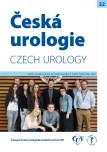Impact of stone density and size on the effect of flexible ureterorenoscopy with laser lithotripsy
Authors:
Iveta Štrajtová; Peter Dančík; Rostislav Kuldan
Authors‘ workplace:
Městská nemocnice, Ostrava
Published in:
Ces Urol 2018; 22(3): 188-196
Category:
Original Articles
Overview
Introduction:
Flexible ureterorenoscopy (URS) is an endoscopic method which allows visualization of the urinary tract into the kidney in a minimally invasive way. It also allows us to remove stones with using laser and extraction baskets. At present, the knowledge about the impact of stone density on the effect of laser lithotripsy is insufficient. Most previous work deals with a possible prediction of shock wave lithotripsy (ESWL) success.
Purpose:
The aim of this work is to evaluate the possible influence of stone density in Hounsfield units (HU) on CT scans on the result of flexible URS with laser lithotripsy. Also, the influence of cumulative stone size of specific nephroliths is evaluated.
Methods:
For the work, we compiled a total of 109 patients which have undergone the flexible URS for nephrolithiasis in our department since September 2008 to January 2016. In these patients, CT scans had been preoperatively obtained and also cumulative stone size and density in HU had been measured. After the surgery, the result was recorded with using peroperative process, ultrasonography and X‑ray imaging. Subjects were divided into 3 groups according to surgery results. In these groups, the correction by initial stone size was made. The endoscopy results were also connected with stone size.
Results:
The results of the flexible URS varied depending on the size groups. There was not a correlation between the resultant surgery effect and the initial density. After recalculating the results in the individual size groups we also didn’t record any connection in the studied relationship. When we focus on the stone size, we have noticed a significant relationship in terms of indirect proportion. Conclusion: By evaluating the whole patient group after flexible URS, we didn’t demonstrate a significant relationship between stone density in HU and the surgery effect. On the contrary, we confirmed the correlation between the stone cumulative size and endoscopy results.
KEY WORDS
Flexible ureterorenoscopy, stone density, stone size.
Sources
1. Türk C, Drake T, Grivas N, et al. EAU Guidelines. Guidelines on urolithiasis. Uroweb (online) 2018. http:// uroweb.org/guideline/urolithiasis/#3_4.
2. Zaplatílek J. Flexibilní ureterorenoskopie a laser v léčbě patologií horních močových cest. Urol. Praxi 2013; 14(5): 215–217.
3. Hora M, Babjuk M, Broďák M, et al. Stěžejní urologické operační výkony v urologii v ČR v letech 2009–2014. Ces Urol 2016; 20(2): 135–140.
4. L’upták J. Urolitiáza. 1. ed. Martin 2012; 18–19.
5. Fogl J, Šámal V, Mečl J, Šulc J. Je denzita konkrementu při CT vyšetření prediktivním faktorem chemického složení? Urol. Praxi 2012; 13(3): 127–129.
6. Wiesenthal JD, Ghiculete D, D`A Honey RJ, Pace KT. Evaluating the importance of mean stone density and skin‑to‑stone distance in predicting successful shock wave lithotripsy of renal and ureteric calculi. Urol Res. 2010; 38 4): 307–313.
7. Yamashita S, Kohjimoto Y, Iwahashi Y, et al. Automatic measurement of mean stone density by three‑dimensional stone images for predicting shock wave lithotripsy success. European Urology Supplements 2018; 17(2): 1108–1109.
8. Pšenčík L. Extrakorporální litotrypse rázovou vlnou v současné urologické praxi. Ces Urol 2014, 18(4): 288–299.
9. el‑Assmy A, Abou ‑ el‑Ghar ME, el‑Nahas AR, Refaie HF, Sheir KZ. Multidetector computed tomography: role in determination of urinary stones composition and disintegration with extra‑corporeal shock wave lithotripsy – an in vitro study. Urology 2011; 77(2): 286–290.
10. Williams Jr. JC, Zarse CA, Jackson ME, Lingeman JE, McAteer JA. Using helical CT to predict stone fragility in shock wave lithotripsy (SWL). AIP Conference Proceedings 2007; 900 : 326–339.
11. Zarse CA, Hameed TA, Jackson ME, et al. CT visible internal stone structure, but not Houns‑field unit value, of calcium oxalate monohydrate (COM) calculi predicts lithotripsy fragility in vitro. Urol Res. 2007; 35(4): 201–206.
12. Kim SC, Burns EK, Lingeman JE, et al. Cystine calculi: correlation of CT‑visible structure, CT number, and stone morphology with fragmentation by shock wave lithotripsy. Urol Res. 2007; 35(6): 319–324.
13. Joo YL, Dong HK, Jae HK, et. al. Stone heterogeneity index defined as the standard deviation of Hounsfield units on non‑contrast computed tomography is a novel predictor for shock‑wave lithotripsy outcomes in ureteral calculi. European Urology Supplements 2016; 15(3): e463.
14. Yamashita S, Kohjimoto Y, Iguchi T, Hara I. Variation coefficient of density: a novel predictor of treatment outcome following extracorporeal shockwave lithotripsy. The Journal of Urology 2017; 197(4): e827–e828.
15. Andrabi Y, Patino M, Das CJ. Advances in CT imaging for urolithiasis. Indian J Urol. 2015; 31(3): 185–193.
16. Yamashita S, Kohjimoto Y, Iba A, Kikkawa K, Hara I. Stone size is a predictor for residual stone and multiple procedures of endoscopic combined intrarenal surgery. Scand J Urol. 2017; 51(2): 159–164.
Labels
Paediatric urologist Nephrology UrologyArticle was published in
Czech Urology

2018 Issue 3
Most read in this issue
- Extended recommendation for management of paediatric enuresis
- Impact of stone density and size on the effect of flexible ureterorenoscopy with laser lithotripsy
- Frequency of intermittent catheterization in patients with spinal cord lesion
- Adenocarcinoma of sigmoid bladder augmentation
